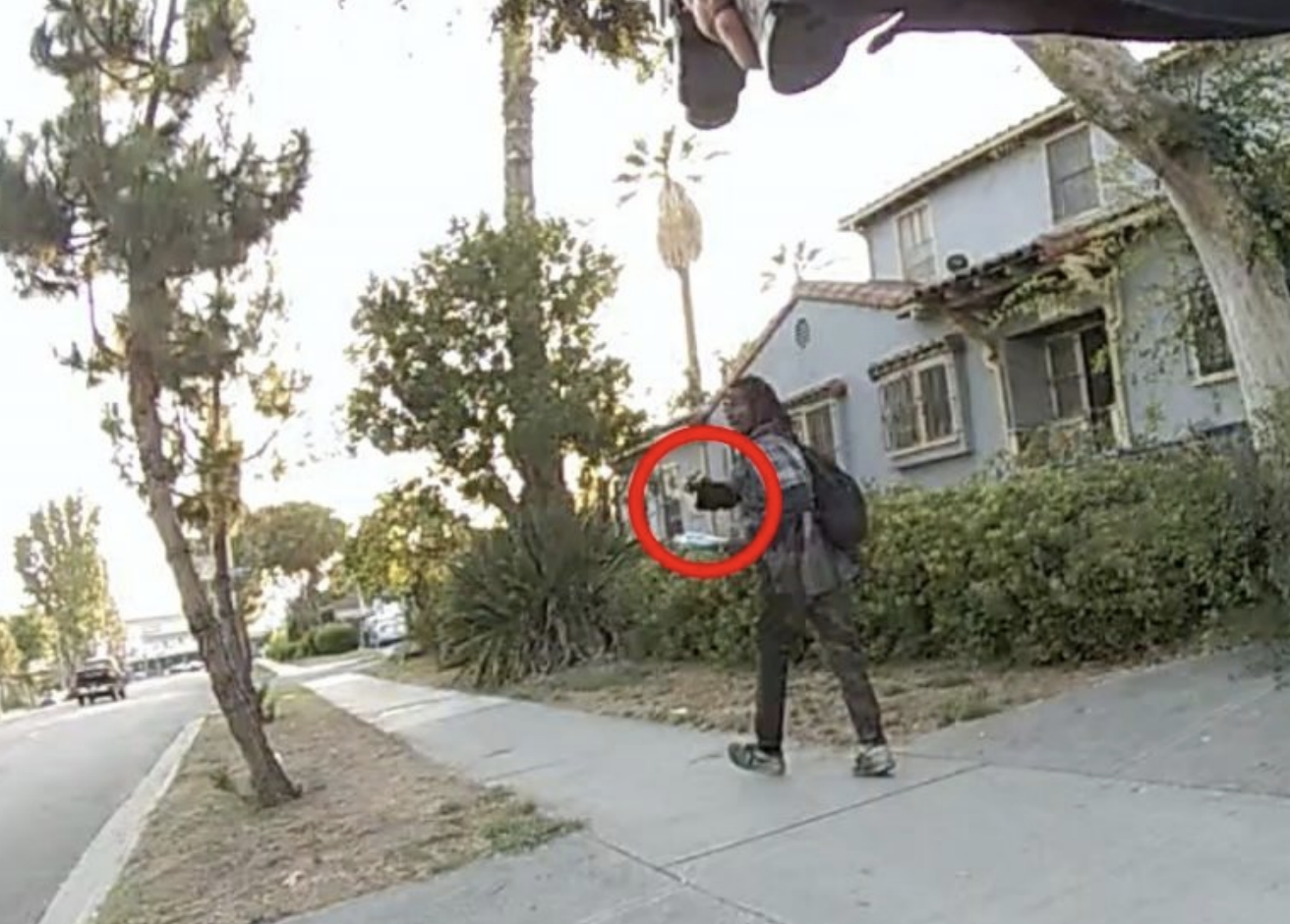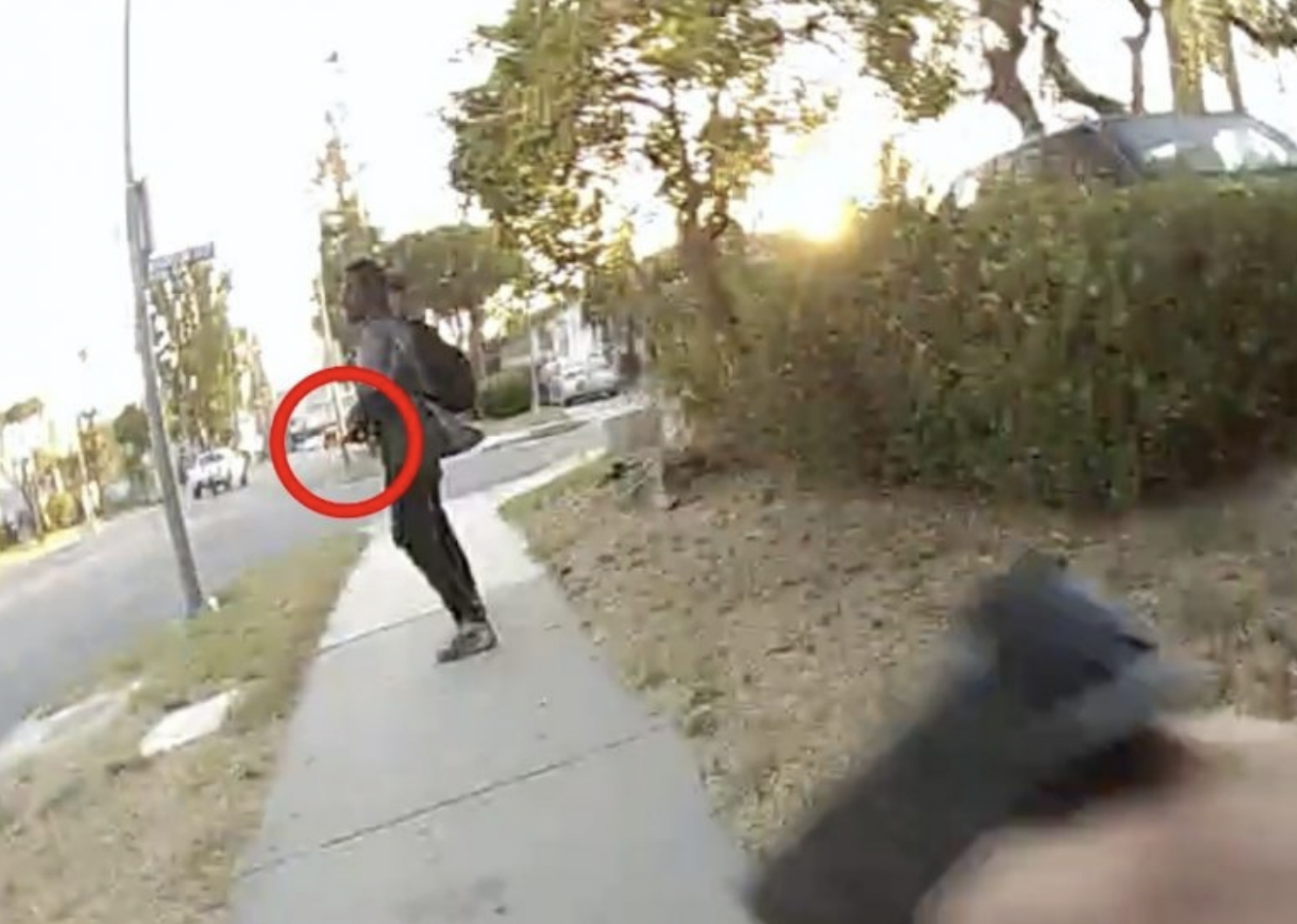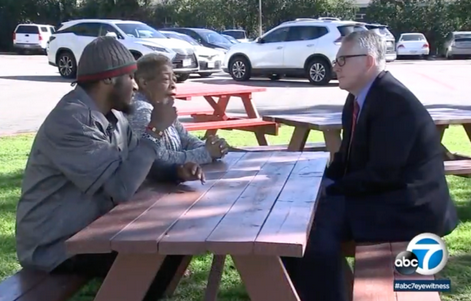The question from Gina Fields, chairperson for the Empowerment Congress West Area Neighborhood Council, was straightforward enough: Did 39-year-old Jermaine Petit, a Black veteran with a well-documented history of mental illness shot by LAPD in Leimert Park on July 18, have a gun or not?
A simple "no" would have sufficed.
But as we have catalogued time and time and time again, LAPD tends to respond to questions about subjects' actions or specific objects they were holding with answers about the threats that officers perceived.
So instead of telling participants in last night's hastily set-up "town hall" on the shooting that Petit had been holding a latch actuator (the car part seen below), Captain Rudy Lopez riffed on what he might have imagined the object to have been if he had been on the scene at the time.
"It was not a gun itself, no..." said Lopez.
"It resembled a gun. It was a hard metal object. I'm gonna give my own opinion on it - if I'd saw that he was carrying it and I had information from a witness that he was pointing that at me, I would have believed it was a gun, but it was a nonfunctioning firearm."
Though this reporter asked for clarification on what a "nonfunctioning firearm" was and why it would be considered a threat, the LAPD never got to questions placed in the chat. Instead, they openly expressed annoyance at participants' concerns and abruptly ended the zoom session after just half an hour.
It was shocking, but not surprising.
LAPD had come out of the gate swinging. The purpose of the town hall, Lopez had explained in his opening remarks, was to answer community questions and dispel "rumors...that the media had put out that were not accurate."
Never mind that LAPD themselves had been the ones to report Petit was armed with a weapon on the night of the shooting, despite intense probing by LAPD critic and chronicler William Gude (@FilmThePoliceLA).
MLK & Degnan, Leimert Park:
— Film The Police LA (@FilmThePoliceLA) July 19, 2022
LAPD shot a Black man in the back three times. They refuse to say if he had a gun. pic.twitter.com/t8KunxaUM3
LAPD would not backtrack on that claim until the next morning, when Chief Michel Moore told the Police Commission that Petit had been carrying a "black metal latch actuator" and had refused to respond to commands.
It was the only new detailed offered.
No reason was given for the shooting; instead, the unusual wording of Moore's message seemed to suggest the "officer-involved shooting" was prompted by the arrival of the uniformed supervisor (more on that below).
LAPD Chief says man shot by officers in Leimert Park Monday night - was holding a "black metal latch actuator" - not a gun. No explanation by chief at today's @lapdcommission as to -why- officers fired. Chief promised image of the 'actuator' will be shared soon. @nbcla pic.twitter.com/UMmK9i9keA
— Eric Leonard (@LeonardFiles) July 19, 2022
Despite this, Lopez kicked off last night's town hall by suggesting Petit had, in fact, been armed, saying, "There was some bad information that was put out [by the media] - that the suspect was unarmed."
A confusing statement at first, it soon became clear that the goal of the town hall was not to discuss the objective facts of the case but to explain how the 911 call had led officers to believe Petit was armed. Or to help participants grasp "the facts of what transpired - what the officers knew," as Lopez put it.
Per Lopez' synopsis, the genesis of the incident was the confrontation a citizen had with Petit after he told Petit to stop going through the trash. Lopez said Petit had "violently approached that citizen, threatened him with a stick, and also the citizen believed that the guy had a gun and pointed that gun at him," prompting the citizen to call 911.
"So bear in mind," said Lopez, "this is what the officers knew at the time."
Lopez immediately amended that statement to explain that the citizen also followed the person he said had pointed a gun at him.
"So that is something that's important in the minds of the officers," he said. "We have a citizen following a suspect that has a gun."
When police arrived on the scene, Lopez continued, they told Petit to "drop the gun." Petit refused, "point[ed] this object at officers," and continued to walk some distance before making an [unspecified] motion with the hand holding the supposed gun. It was apparently at that point that officers Brett Hayhoe and Daryl Glover opened fire, hitting Petit twice.
South Bureau Deputy Chief Gerald Woodyard backed up Lopez' account, saying he had watched the video (presumably body cam footage from the incident) and also listened to the 911 call.
But rather than speak to what was captured in the footage, shed any more light on the exchange officers had with Petit that night, or discuss LAPD's response to those clearly exhibiting mental health issues, Woodyard spoke about how shaken up the 911 caller sounded.
"The caller actually indicated that, you know, they believed that the individual had a gun in his hand," said Woodyard. "But what was important to me was it sounded like the caller was a little - not panicked - but shook up because he believed that someone had pointed a gun at him as well."
The focus on the 911 call was no accident.
A transcript of the call was even included in LAPD's official statement in the days following the incident (below), just so people could see for themselves that officers had indeed been led to believe that Petit was carrying a firearm.
Establishing a basis for "officer fear" - even a false one - helps LAPD justify the use of force.
But the singular focus on the 911 call also means LAPD is effectively making the case that officers have no obligation to attempt to verify what is happening at a scene before opening fire on subjects.
Woodyard's claim to have heard how "shook up" the caller was, for example, paints the picture of an active threat that LAPD's own incident summary and footage do not.
The still images LAPD posted with its official statement show Petit walking away from officers while holding something in his hand. At most, he appears to be feeling hassled or stressed. He does not appear to point anything at them.

Even the half-hearted attempt to suggest - in line with Moore's comments to the police commission - that Petit was preparing to fire at the vehicle of the arriving supervisor doesn't square up with the image of Petit below.
If these two screen grabs represent the most threatening stances Petit assumed during the "multiple times" he is said to have turned toward officers and pointed his actuator at them, it's not hard to see why the public's focus is being directed elsewhere.

Before LAPD logged off, Gude attempted to engage them about what Petit was being charged with.
He wanted to know why LAPD had labeled Petit an "assault with a deadly weapon suspect" when they knew he wasn't carrying a weapon. He also wanted to know what charges Petit would be facing once he had recovered. LAPD had made it known that Petit had had warrants unrelated to this case, but had not clarified whether the charges he was currently booked on were for those warrants or for this case. [Per the LASD inmate locator, there are currently two charges, and bail for Petit is set at $100,000.]
But Lopez wouldn't give any specifics regarding what those charges might be. "That does not fall under Southwest's purview," said Lopez. "It's under [the Force Investigations Division]."
Meaning the public will have to wait until the critical incident briefing is released... five weeks from now.
_________
Update 7/29, 7:45 p.m.: Petit was booked for two felony warrants: Assault with a Deadly Weapon and Resisting an Executive Officer. Given that Petit was said to have had pending warrants, it is not completely clear if both of these charges are related to the present case. Many thanks to William Gude for passing this information on.The shooting of Jermaine Petit was the 20th "officer-involved shooting" this year by LAPD. Since then, LAPD has shot at three more people, two of whom were also carrying non-lethal objects. For more on the killing of a man carrying a pellet gun, see Lexis Olivier-Ray's recent story at L.A. Taco.
William Gude/@FilmThePoliceLA was on the scene the night of Jermaine Petit's shooting. His twitter thread can be found here; please note, it does contain graphic footage.
The 2019 ABC7 report on Jermaine Petit by Carlos Granda can be found here.
Find me on twitter, @sahrasulaiman. See some of our recent breakdowns of LAPD narratives below:
- Travis Elster's case: LAPD Shooting at Manchester/Fig Ruled Out of Policy, but Officer's False Claim About Threatening Finger Guns Allowed to Stand; Officer Fires 8 Wildly Out-of-Policy Shots at Man Fleeing Pretextual Stop; Evolving LAPD Statements Attempt to Pin Blame on Driver
- Margarito "Junior" López' case: Officers Who Killed Margarito López Didn't Heed Standby Warning for "Less Lethal" Fire
- The 27th St. Fireworks Detonation: Anatomy of an Officer-Involved Explosion: a Post-Mortem on LAPD's E. 27th Street Fireworks Blast
- Richard Castillo's case: How Beating of Unhoused Boyle Heights Man Exposes Woeful Inadequacy of LAPD Reform Proposals






